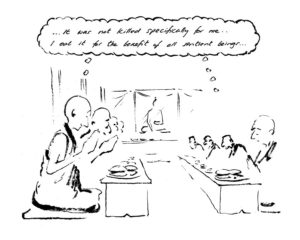Definition of the Week (20) – The Emanation Body of a Buddha
Jetsün Chokyi Gyaltsen:
Definition of the emanation body of a buddha: A final form body not endowed with the five certainties.
Divisions:
- The artisan emanation body; e.g., the musician emanated to subdue the Gandava king.
- The born emanation body; e.g., animal-like emanations.
- The emanation body of great enlightenment; e.g., Amithaba.
- The supreme emanation body; e.g., Shakyamuni Buddha.
Panchen Losang Choky Gyaltsen:
Compassionate prayers and the wishes 9d
Of those to be subdued – due to this collection of causes, 10
The truth body, enjoyment body, emanation body,
As well as the grounds, paths, qualities, activities and so forth,
Exist, but only in mere appearance.
They are not seen as existing in reality. 11
Choden Rinpoche:
“The truth body that never arises from emptiness is a transcendental wisdom in single pointed equipoise on emptiness. Due to the compassion of Shakyamuni Buddha and the prayers of the disciples it arises as a physical body in accordance with the wishes of the disciples.
Due to the presence of the three conditions of compassion, the disciples prayers and wishes it arises in the aspect of the emanation body, enjoyment body, the twenty-seven enlightened activities and so forth. Due to the wishes of the disciples to some it appears in the aspect of Yamantaka, for others again in the aspect of a bikkhu as Shakyamuni Buddha. To yet others, to which he cannot appear like this, he appears as the virtuous friend.
From Shakyamuni Buddha’s own side exists absolutely no thought of ‘I shall appear like this to this person’, or ‘it is unsuitable to appear to that person like that’. For example, when the moon shines in the sky, it appears different in different bodies of water. The moon appears in different grades of clarity according to the different purities of the water. But the moon from his side has no thought of ‘Here I shall appear clearer and here not’, but relative to the clarity of the water the moon appears in some bodies of water clearer as in others. Similarly, also Shakyamuni Buddha appears different to different disciples according to their minds and dispositions.
The qualities of the grounds and paths, i.e. the ten grounds and five paths contained in the disciples’ continuums, and the enlightened activities and so forth, do not at all exist from their own side but are a mere appearance to conceptual thought, a mere imputation by name. They are not seen as existing in meaning. Any virtue that is generated in the disciples’ continuums is regarded as enlightened activity of the buddhas.
All phenomena, starting from the dharmas on the level of enlightenment down to the phenomena contained in cyclic existence, they all do not exist truly, they do not have a self, they do not exist from their own side. If one asks how they exist, they exist as mere appearances to thought, as mere imputations by name, and in no other way.”


